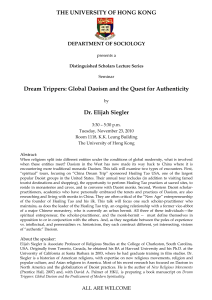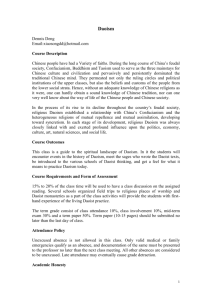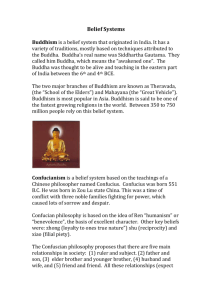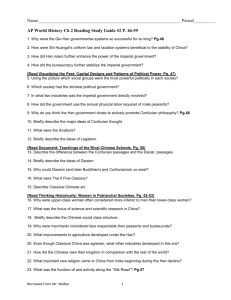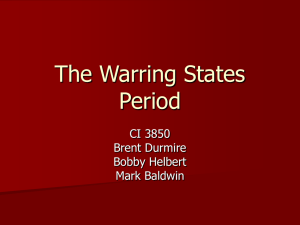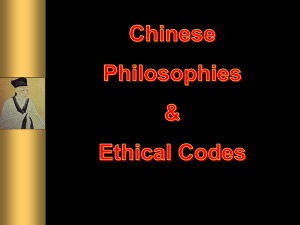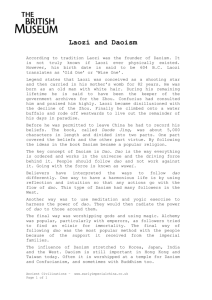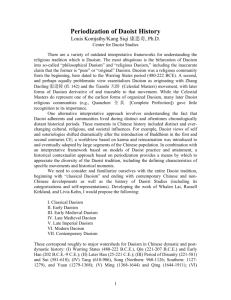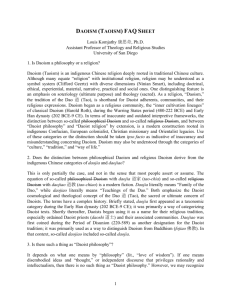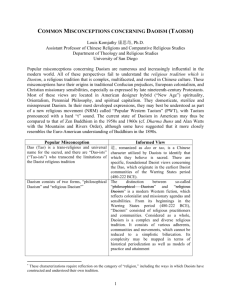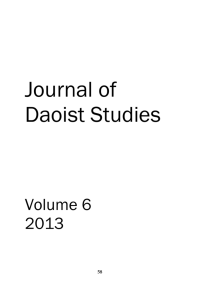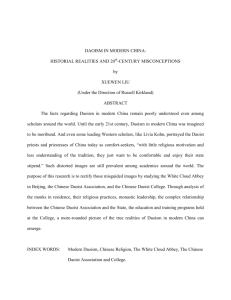The Chinese University of Hong Kong
advertisement
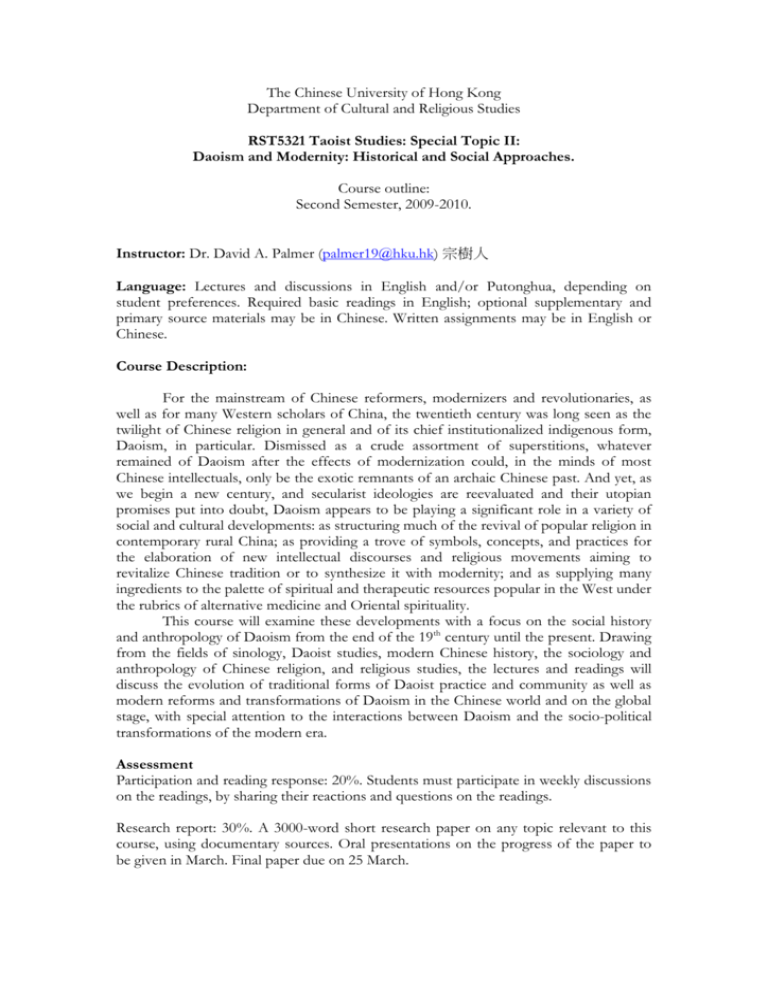
The Chinese University of Hong Kong Department of Cultural and Religious Studies RST5321 Taoist Studies: Special Topic II: Daoism and Modernity: Historical and Social Approaches. Course outline: Second Semester, 2009-2010. Instructor: Dr. David A. Palmer (palmer19@hku.hk) 宗樹人 Language: Lectures and discussions in English and/or Putonghua, depending on student preferences. Required basic readings in English; optional supplementary and primary source materials may be in Chinese. Written assignments may be in English or Chinese. Course Description: For the mainstream of Chinese reformers, modernizers and revolutionaries, as well as for many Western scholars of China, the twentieth century was long seen as the twilight of Chinese religion in general and of its chief institutionalized indigenous form, Daoism, in particular. Dismissed as a crude assortment of superstitions, whatever remained of Daoism after the effects of modernization could, in the minds of most Chinese intellectuals, only be the exotic remnants of an archaic Chinese past. And yet, as we begin a new century, and secularist ideologies are reevaluated and their utopian promises put into doubt, Daoism appears to be playing a significant role in a variety of social and cultural developments: as structuring much of the revival of popular religion in contemporary rural China; as providing a trove of symbols, concepts, and practices for the elaboration of new intellectual discourses and religious movements aiming to revitalize Chinese tradition or to synthesize it with modernity; and as supplying many ingredients to the palette of spiritual and therapeutic resources popular in the West under the rubrics of alternative medicine and Oriental spirituality. This course will examine these developments with a focus on the social history and anthropology of Daoism from the end of the 19th century until the present. Drawing from the fields of sinology, Daoist studies, modern Chinese history, the sociology and anthropology of Chinese religion, and religious studies, the lectures and readings will discuss the evolution of traditional forms of Daoist practice and community as well as modern reforms and transformations of Daoism in the Chinese world and on the global stage, with special attention to the interactions between Daoism and the socio-political transformations of the modern era. Assessment Participation and reading response: 20%. Students must participate in weekly discussions on the readings, by sharing their reactions and questions on the readings. Research report: 30%. A 3000-word short research paper on any topic relevant to this course, using documentary sources. Oral presentations on the progress of the paper to be given in March. Final paper due on 25 March. Ethnographic research report: 50%. A 5000-word report on ethnographic field research on a contemporary Daoist community, group, ritual or practice. Oral presentations on your project to be given in April. Final report due on May 6. Readings. Most required readings are case studies taken from chapters in David A. Palmer and Xun LIU, eds., Daoism in the 20th Century: Between Eternity and Modernity. Berkeley: University of California Press, forthcoming (copies of chapters to be provided to students or in a course pack) as well as other articles (see list of required readings below). A bibliography of additional suggested readings will be provided. Some primary texts will be assigned as well. Course calendar: Week 1: Jan. 14: Introduction: the Daoist Encounter with Modernity. Text: D. Palmer & X. Liu, “Introduction,” in Daoism in the 20th Century. Week 2: Jan. 21: Daoism in the Late Imperial Religious Landscape. Text: V. Goossaert, “The Late Qing Landscape,” in D. Palmer & V. Goossaert, The Religious Question in Modern China, Chicago: University of Chicago Press, forthcoming. Week 3: Jan. 28: Zhengyi Daoists and Modernist Anti-Superstition Campaigns. Text: Lai Chi-tim, “Zhengyi Daoist Masters in the Pearl River Delta: Ruptures and Continuities in the Transmission of Tradition,” in Daoism in the 20th Century. Week 4: Feb. 4: The Sociology of Daoist Self-Cultivation in Republican Chinese Cities. Text: V. Goossaert, “Daoists in the Modern Self-Cultivation Market: the Case of Beijing, 1850-1949,” in Daoism in the 20th Century. Week 5: Feb. 11: The Modernization of Daoist Inner Alchemy. Text: X. Liu, “Scientizing the Body for the Nation: Chen Yingning and the Reinvention of Daoist Inner Alchemy in 1930s Shanghai,” in Daoism in the 20th Century. Week 6. Feb. 25: Daoism and New Religious Movements (Redemptive Societies) of the Republican Era. Text: D. Palmer, “Dao and Nation. Li Yujie: May Fourth Activist, Daoist Reformer and Redemptive Society Patriarch in Mainland China and Taiwan,” in Daoism in the 20th Century. Week 7. Mar. 4: Daoism and the Qigong movement in the Peoples’ Republic of China. Text: Lü Xichen, “Yuanji dao: Reform and transformation of a Daoist qigong movement in post-Mao China,” in Daoism in the 20th Century; D. Palmer, “Body Cultivation in Contemporary China,” in James Miller ed., Chinese Religions in Contemporary Societies, Santa Barbara: ABC-Clio, 2006. Week 8. Mar. 11: PRC Religious Policy and Daoism. Text: V. Goossaert and Fang Ling, "Temples and Daoists in Urban China since 1980." China Perspectives 4 (2009): pp. 32-40. Week 9: Mar. 18: The Modern Training of Daoist Priests and its Consequences. Text: Yang Der-ruey, “Revolution of Temporality: The Modern Schooling of Daoist Priests in Shanghai at the turn of the 21st century,” in Daoism in the 20th Century. Week 10: Mar. 25: Quanzhen Daoism in Contemporary China. Text: A. Herrou, “Daoist Monasticism at the Turn of the 21st Century: Ethnography of a Quanzhen Community in Shaanxi Province,” in Daoism in the 20th Century. Week 11: April 8: Daoism in Rural Communal Religion in Contemporary China. Text: K. Dean, Taoist Ritual and Popular Cults in Southeast China. Princeton: Princeton University Press, 1993. Week 12: April 15: Daoism and Globalization (I): Chinese Diasporas. Text: K. Dean, “Daoists and Transnational Chinese Society: The Circulation of Daoist Priests, Three in One Self-Cultivators, and Spirit Mediums between Fujian and SouthEast Asia,” in Daoism in the 20th Century. Week 13: April 22: Daoism and Globalization (II): Daoism in the West. Text: E. Siegler, “Daoism Beyond Modernity: The “Healing Tao” as Postmodern Movement,” in Daoism in the 20th Century.
